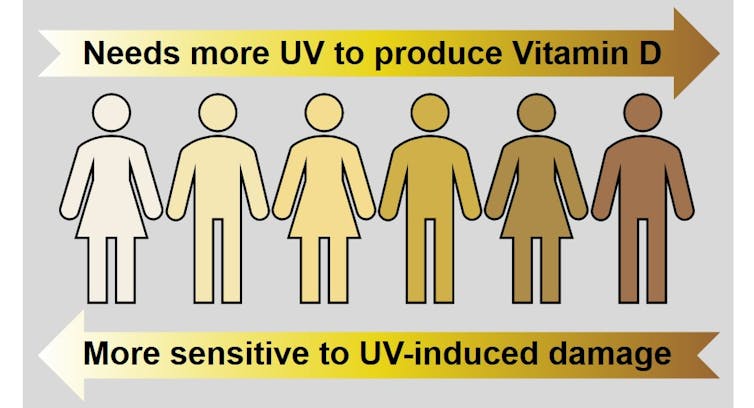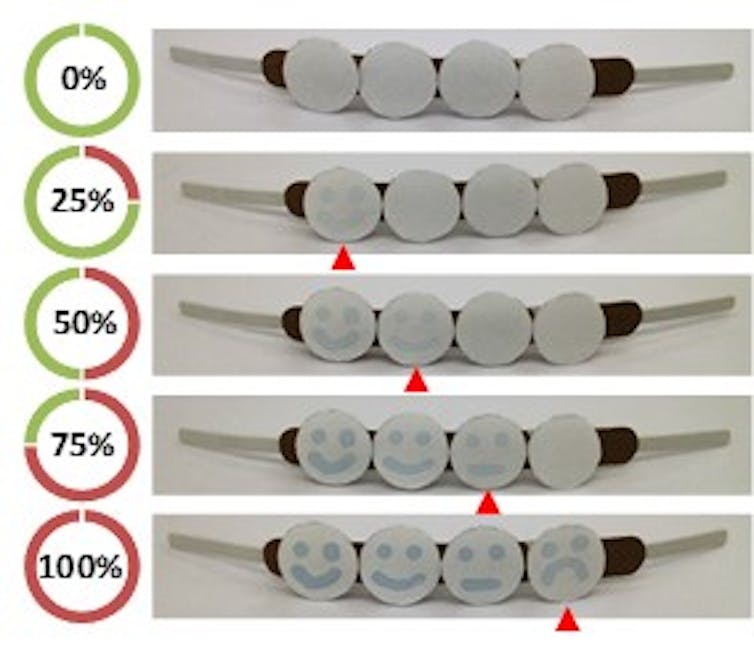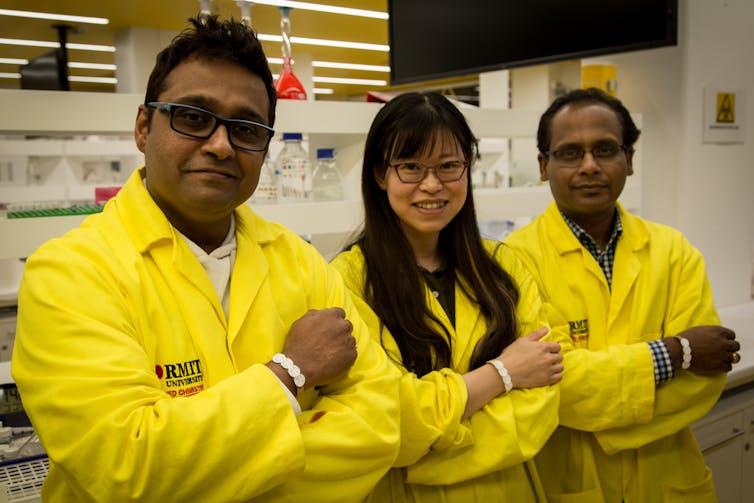New colour change wristbands help you balance too much sun vs not enough – no matter your skin tone
- Written by Vipul Bansal, Professor, ARC Future Fellow & Founding Director, Sir Ian Potter NanoBioSensing Facility, RMIT University
The sun’s ultraviolet (UV) radiations have both harmful and beneficial effects for our health. Too much exposure can lead to sunburn, skin ageing, eye damage or even skin cancer. With too little UV we may become vitamin D deficient.
This big challenge of managing our daily UV exposure limits motivated my colleagues and I to develop a low-cost, paper-based sensor people can wear. The colour produced by our sensor indicates when you have achieved 25%, 50%, 75% and 100% of your daily recommended UV exposure.
To accommodate our ethnically-diverse population, we developed six such sensors, each personalised for a particular skin tonality.
The key discovery behind our sensor is an invisible ink that develops a colour when exposed to the UV rays.
We published these findings today in Nature Communications.
 Personalised paper-based wearable solar UV sensors suitable for people of different skin tones.
Vipul Bansal, RMIT, Author provided
Personalised paper-based wearable solar UV sensors suitable for people of different skin tones.
Vipul Bansal, RMIT, Author provided
Problems with the UV index
When you step outside your home do you notice the intensity of the sun?
If it’s cloudy where you live today, perhaps you assumed you didn’t need protection. If the sun felt intense, maybe you put on sunscreen and a hat.
But irrespective of your judgement about this risk, in reality UV rays neither feel hot (it’s the infrared rays that do this), nor are they visible to the human eye.
So, how do you track UV intensity?
Your current option is the UV index. This is a number calculated by the Australian Radiation Protection and Nuclear Safety Agency (ARPANSA) that tells you whether the UV intensity is low, moderate, high, very high or extreme.
But UV index is a rather blunt tool: it still leaves you wondering about when and for how long you should step out for your vitamin D dose, and when should you go back inside to minimise skin cancer risk.
 A cartoon depicting different Sun exposure needs of individuals based on their skin tonalities.
Wenyue Zou, RMIT, Author provided
A cartoon depicting different Sun exposure needs of individuals based on their skin tonalities.
Wenyue Zou, RMIT, Author provided
Our reliance on the UV index is further complicated by the fact that it’s calculated for a fair skin tone. While lighter skinned individuals are more prone to UV damage, darker skin needs much more sunlight to produce enough vitamin D – which is vital for strong bones and other aspects of health.
This means the current UV index may not be suited to our ethnically-diverse population. And substituting sunlight with oral vitamin D supplements may not always be a good solution either, as a number of factors – including certain medications – interfere with oral vitamin D metabolism.
UV sensitive ink
As another way to measure UV exposure, we developed sensor paper made with an ink that changes colour in the presence of UV radiation.
An important component of this ink is a polyoxometalate molecule. It belongs to a family of materials described as “multi-redox photo-electrochromic” – meaning they can produce different intensities and tonalities of colours when excited with different energies.
We know that solar UV irradiation is comprised of different types of UV waves – so our unique ink responds to these different kinds of radiation and produces distinct colours that are visible to the naked eye.
Using this initially-invisible ink, we can draw or print a design on a paper or any other surface. On exposure to UV, the ink starts to become coloured. The colour intensity allows us to track our total UV exposure in real time.
By changing the ink composition and the sensor design, we can make the ink to develop colour either slow or faster. This allows us to produce sensors for people with different skin tonalities and sun exposure needs.
Wearable wrist bands
This low-cost paper-based technology also offers design flexibility to produce UV sensors as stickers, hairbands and wristbands.
 A paper-based solar UV sensor prototype in a wristband format after different levels of permissible solar UV exposure. The smileys are initially invisible, but they become blue from left to right after 25%, 50%, 75% and 100% sun-safe UV exposure limits.
Wenyue Zou, RMIT, Author provided
A paper-based solar UV sensor prototype in a wristband format after different levels of permissible solar UV exposure. The smileys are initially invisible, but they become blue from left to right after 25%, 50%, 75% and 100% sun-safe UV exposure limits.
Wenyue Zou, RMIT, Author provided
Currently, the sensor comes as a wearable wristband with four smiley faces. As the wearer is exposed to more and more UV with increasing time in the sun, the smileys start lighting up one after another. Finally, a sad smiley appears when the wearer approaches their maximum-allowed UV dose – this acts as a warning sign to leave the Sun.
We have successfully tested the performance of these sensors across various environmental conditions, such as changing humidity, temperature and altitude.
The next stage is to distribute UV sensor prototypes to volunteers to collect sensor response data. This feedback will also assist in optimising the sensor design before we progress towards third-party validation, certification and manufacturing.
Applications outside of health
Overall, we are excited that our modular paper-based UV sensor technology will be useful in helping people negotiate the delicate balance between not enough and too much UV exposure.
 The developers of the colour-changing UV sensors model their wrist bands (L to R: Rajesh Ramanthan, Wenyue Zou and Vipul Bansal).
RMIT, Author provided
The developers of the colour-changing UV sensors model their wrist bands (L to R: Rajesh Ramanthan, Wenyue Zou and Vipul Bansal).
RMIT, Author provided
But UV rays not only directly impact humans – they also have complex effects on the growth of our agricultural crops, and shelf-lives of many consumer, industrial and defence products.
Our UV sensors show large dynamic range – this means that they can detect extremely low as well as extremely high UV doses. This feature may be particularly promising for those industries that wish to assess the long-term impact of UV rays on their outdoor products.
Authors: Vipul Bansal, Professor, ARC Future Fellow & Founding Director, Sir Ian Potter NanoBioSensing Facility, RMIT University



















